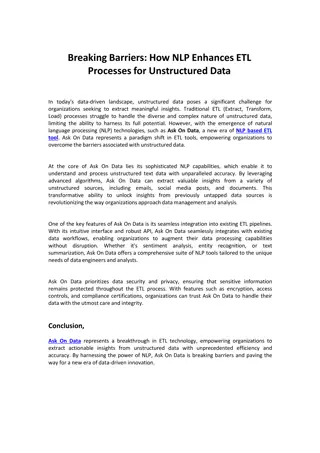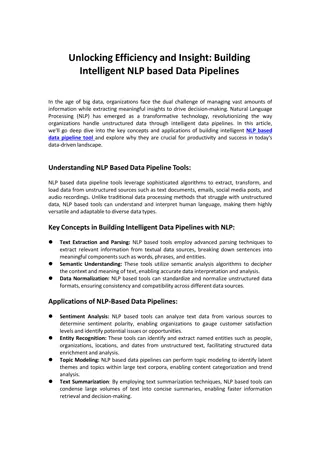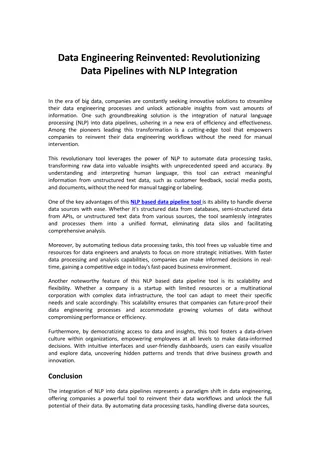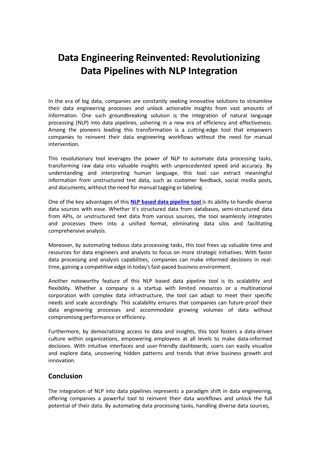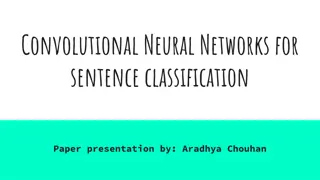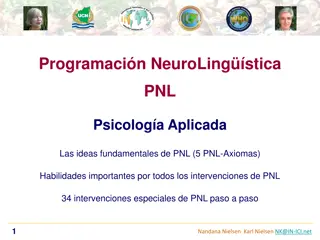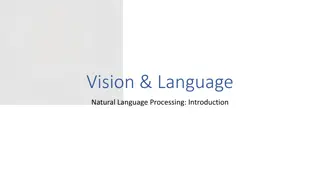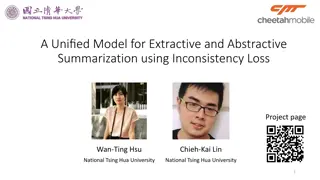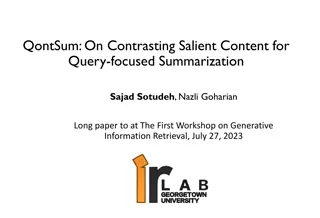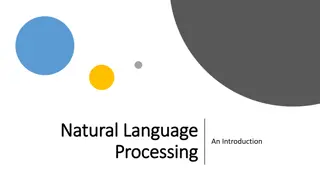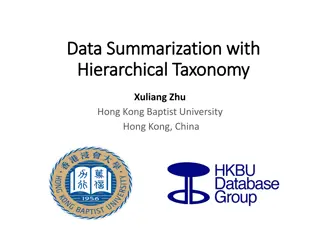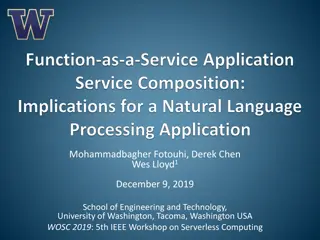Introduction to NLP Summarization Techniques
This content delves into various techniques used in Natural Language Processing (NLP) for text summarization. It covers methods such as Hidden Markov Models, MaxEnt models, and Lexrank algorithm for single and multi-document summarization. The provided snippets highlight different approaches to summarization, including capturing local dependencies, considering feature dependencies, and utilizing graph-based methods.
Download Presentation

Please find below an Image/Link to download the presentation.
The content on the website is provided AS IS for your information and personal use only. It may not be sold, licensed, or shared on other websites without obtaining consent from the author.If you encounter any issues during the download, it is possible that the publisher has removed the file from their server.
You are allowed to download the files provided on this website for personal or commercial use, subject to the condition that they are used lawfully. All files are the property of their respective owners.
The content on the website is provided AS IS for your information and personal use only. It may not be sold, licensed, or shared on other websites without obtaining consent from the author.
E N D
Presentation Transcript
Introduction to NLP Summarization Techniques 3/3
Conroy and OLeary (2001) Using Hidden Markov Models Takes into account the local dependencies between sentences Features Position, number of terms, similarity to document terms Properties HMM alternates between summary and non-summary states Tuned to extract lead sentences and additional supporting sentences
Osborne (2002) Don t assume feature independence Use maxent (log-linear) models Better than Na ve Bayes Features Sentence length Sentence position Inside introduction Inside conclusion
Lexrank (Erkan and Radev 2004) Single and multi-document summarization Lexical Centrality Represent text as graph Graph centrality Graph clustering Random walks
Lexrank 1 (d1s1) Iraqi Vice President Taha Yassin Ramadan announced today, Sunday, that Iraq refuses to back down from its decision to stop cooperating with disarmament inspectors before its demands are met. 2 (d2s1) Iraqi Vice president Taha Yassin Ramadan announced today, Thursday, that Iraq rejects cooperating with the United Nations except on the issue of lifting the blockade imposed upon it since the year 1990. 3 (d2s2) Ramadan told reporters in Baghdad that "Iraq cannot deal positively with whoever represents the Security Council unless there was a clear stance on the issue of lifting the blockade off of it. 4 (d2s3) Baghdad had decided late last October to completely cease cooperating with the inspectors of the United Nations Special Commission (UNSCOM), in charge of disarming Iraq's weapons, and whose work became very limited since the fifth of August, and announced it will not resume its cooperation with the Commission even if it were subjected to a military operation. 5 (d3s1) The Russian Foreign Minister, Igor Ivanov, warned today, Wednesday against using force against Iraq, which will destroy, according to him, seven years of difficult diplomatic work and will complicate the regional situation in the area. 6 (d3s2) Ivanov contended that carrying out air strikes against Iraq, who refuses to cooperate with the United Nations inspectors, ``will end the tremendous work achieved by the international group during the past seven years and will complicate the situation in the region.'' 7 (d3s3) Nevertheless, Ivanov stressed that Baghdad must resume working with the Special Commission in charge of disarming the Iraqi weapons of mass destruction (UNSCOM). 8 (d4s1) The Special Representative of the United Nations Secretary-General in Baghdad, Prakash Shah, announced today, Wednesday, after meeting with the Iraqi Deputy Prime Minister Tariq Aziz, that Iraq refuses to back down from its decision to cut off cooperation with the disarmament inspectors. 9 (d5s1) British Prime Minister Tony Blair said today, Sunday, that the crisis between the international community and Iraq ``did not end'' and that Britain is still ``ready, prepared, and able to strike Iraq.'' 10 (d5s2) In a gathering with the press held at the Prime Minister's office, Blair contended that the crisis with Iraq ``will not end until Iraq has absolutely and unconditionally respected its commitments'' towards the United Nations. 11 (d5s3) A spokesman for Tony Blair had indicated that the British Prime Minister gave permission to British Air Force Tornado planes stationed in Kuwait to join the aerial bombardment against Iraq.
Lexrank 1 2 3 4 5 6 7 8 9 10 11 1 1.00 0.45 0.02 0.17 0.03 0.22 0.03 0.28 0.06 0.06 0.00 2 0.45 1.00 0.16 0.27 0.03 0.19 0.03 0.21 0.03 0.15 0.00 3 0.02 0.16 1.00 0.03 0.00 0.01 0.03 0.04 0.00 0.01 0.00 4 0.17 0.27 0.03 1.00 0.01 0.16 0.28 0.17 0.00 0.09 0.01 5 0.03 0.03 0.00 0.01 1.00 0.29 0.05 0.15 0.20 0.04 0.18 6 0.22 0.19 0.01 0.16 0.29 1.00 0.05 0.29 0.04 0.20 0.03 7 0.03 0.03 0.03 0.28 0.05 0.05 1.00 0.06 0.00 0.00 0.01 8 0.28 0.21 0.04 0.17 0.15 0.29 0.06 1.00 0.25 0.20 0.17 9 0.06 0.03 0.00 0.00 0.20 0.04 0.00 0.25 1.00 0.26 0.38 10 0.06 0.15 0.01 0.09 0.04 0.20 0.00 0.20 0.26 1.00 0.12 11 0.00 0.00 0.00 0.01 0.18 0.03 0.01 0.17 0.38 0.12 1.00
Lexrank 1 2 3 4 5 6 7 8 9 10 11 1 1.00 0.45 0.02 0.17 0.03 0.22 0.03 0.28 0.06 0.06 0.00 2 0.45 1.00 0.16 0.27 0.03 0.19 0.03 0.21 0.03 0.15 0.00 3 0.02 0.16 1.00 0.03 0.00 0.01 0.03 0.04 0.00 0.01 0.00 4 0.17 0.27 0.03 1.00 0.01 0.16 0.28 0.17 0.00 0.09 0.01 5 0.03 0.03 0.00 0.01 1.00 0.29 0.05 0.15 0.20 0.04 0.18 6 0.22 0.19 0.01 0.16 0.29 1.00 0.05 0.29 0.04 0.20 0.03 7 0.03 0.03 0.03 0.28 0.05 0.05 1.00 0.06 0.00 0.00 0.01 8 0.28 0.21 0.04 0.17 0.15 0.29 0.06 1.00 0.25 0.20 0.17 9 0.06 0.03 0.00 0.00 0.20 0.04 0.00 0.25 1.00 0.26 0.38 10 0.06 0.15 0.01 0.09 0.04 0.20 0.00 0.20 0.26 1.00 0.12 11 0.00 0.00 0.00 0.01 0.18 0.03 0.01 0.17 0.38 0.12 1.00
Cosine centrality (t=0.3) d3s3 d2s3 d3s2 d3s1 d1s1 d4s1 d5s1 d2s1 d5s2 d5s3 d2s2
Cosine centrality (t=0.2) d3s3 d2s3 d3s2 d3s1 d1s1 d4s1 d5s1 d2s1 d5s2 d5s3 d2s2
Cosine centrality (t=0.1) d3s3 d2s3 d3s2 d3s1 d1s1 d4s1 d5s1 d2s1 d5s2 d5s3 d2s2 Sentences vote for the most central sentence!
Cosine centrality (t=0.1) d3s3 d2s3 d3s2 d3s1 d1s1 d4s1 d5s1 d2s1 d5s2 d5s3 d2s2 Sentences vote for the most central sentence!
Lexrank (Advanced Material) Square connectivity matrix Directed vs. undirected An eigenvalue for a square matrix A is a scalar such that there exists a vector x 0 such that Ax = x The normalized eigenvector associated with the largest is called the principal eigenvector of A A matrix is called a stochastic matrix when the sum of entries in each row sum to 1 and none is negative. All stochastic matrices have a principal eigenvector
Lexrank (Advanced Material) The connectivity matrix used in PageRank [Page & al. 1998] is irreducible [Langville & Meyer 2003] An iterative method (power method) can be used to compute the principal eigenvector That eigenvector corresponds to the stationary value of the Markov stochastic process described by the connectivity matrix This is also equivalent to performing a random walk on the matrix
Lexrank (Advanced Material) The stationary value of the Markov stochastic matrix can be computed using an iterative power method: = p E I T p E p = T ( ) 0 PageRank adds an extra twist to deal with dead-end pages. With a probability 1- , a random starting point is chosen. This has a natural interpretation in the case of Web page ranking ] [ v pr u n 1 ( ) p v su = successor nodes pr = predecessor nodes = + ( ) p v | [ | ] u su Eigenvector centrality: the paths in the random walk are weighted by the centrality of the nodes that the path connects
Gong and Liu (2001) Using Latent Semantic Analysis (LSA) Single and multi-document Not using WordNet Each document is represented as a word by sentence matrix (row=word, column=sentence) TF*IDF weights in the matrix SVD: A = USVT The rows of VT are independent topics Select sentences that cover these independent topics


